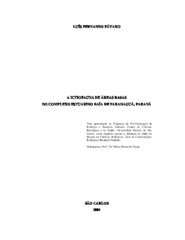| dc.contributor.author | Fávaro, Luís Fernando | |
| dc.date.accessioned | 2016-06-02T19:29:50Z | |
| dc.date.available | 2005-01-17 | |
| dc.date.available | 2016-06-02T19:29:50Z | |
| dc.date.issued | 2004-04-15 | |
| dc.identifier.citation | FÁVARO, Luís Fernando. The ichthyofauna in the shallow waters of the Paranaguá bay estuarine complex, Paraná.. 2004. 92 f. Tese (Doutorado em Ciências Biológicas) - Universidade Federal de São Carlos, São Carlos, 2004. | por |
| dc.identifier.uri | https://repositorio.ufscar.br/handle/ufscar/1774 | |
| dc.description.abstract | The present work investigated the ichthyofauna in the shallow waters of the Paranaguá Bay estuarine complex, Paraná state, Brazil, considering
eight sample sites along the north-south axis. The analyses of the physical and the chemical
data series of the water and the biological data monthly obtained, taking in account the
sediment data series seasonally determined in each site, making possible the environmental
characterization and the quali-quantitative assessment of the local ichthyofauna. The
hydrological parameter values reflecting an environmental gradient defined by the increasing
from the north to the south region of the estuary. The northern sample sites were characterized
by higher continental water influence, lower hydrodynamic and higher fine granules amount
in the sediment. The biological data analyses of the ichthyofauna in the studied area showed
that the complete life cycles of some species take place in this area, emphasized by the
relevant occurrence frequencies of juvenile and adult specimens. In the meantime, the highest
values of the hydrological parameters were registered on the southern sample sites of the
estuary, showing the influence of the marine salt water and characterized by the higher
hydrodynamic forces reflected by the high amount of thick granules in the sediment. The
ichthyofauna is mainly represented by juvenile fish of marine species that utilize the estuary
in some periods of the year and by sporadic marine species. The shallow water ichthyofauna
of the Paranaguá Bay estuarine complex is composed by 96 species with predominance of
occasional species in comparison to the constant ones, indicating a dynamic environment. The
quantitative data analyses of the ichthyofauna showed seasonal differences as in the species
composition as in the catch proportion, resulting in a seasonal characterization of the specific
richness, of the species diversity, of the eveness and of the similarity indices. The results of
the present study emphasize the spatial-temporal heterogeneity of the environment, taking in
account its characteristics and the ichthyofauna composition, revealing that the shallow waters
of Paranaguá Bay estuarine complex constitute a highly dynamic environment. | eng |
| dc.description.sponsorship | Financiadora de Estudos e Projetos | |
| dc.format | application/pdf | por |
| dc.language | por | por |
| dc.publisher | Universidade Federal de São Carlos | por |
| dc.rights | Acesso Aberto | por |
| dc.subject | Ictiologia | por |
| dc.subject | Áreas rasas | por |
| dc.subject | Complexo estuarino Baía de Paranaguá (PR) | por |
| dc.subject | Paranaguá Bay estuarine complex | eng |
| dc.subject | Shallow waters | eng |
| dc.subject | Ichthyofauna | eng |
| dc.title | A ictiofauna de áreas rasas do complexo estuarino baía de Paranaguá, Paraná. | por |
| dc.title.alternative | The ichthyofauna in the shallow waters of the Paranaguá bay estuarine complex, Paraná. | eng |
| dc.type | Tese | por |
| dc.contributor.advisor1 | Verani, Nelsy Fenerich | |
| dc.contributor.advisor1Lattes | http://genos.cnpq.br:12010/dwlattes/owa/prc_imp_cv_int?f_cod=K4788117U4 | por |
| dc.description.resumo | O presente estudo investigou a ictiofauna de áreas rasas no eixo norte-sul do complexo estuarino
Baía de Paranaguá-PR considerando oito pontos amostrais no período de maio de 2000 a abril
de 2001. Através de coletas mensais dos parâmetros físicos e químicos da água e de material
biológico e de coletas sazonais de sedimento em cada área, foi possível caracterizar o
ambiente e analisar a ictiofauna. Os parâmetros hidrológicos, avaliados nas áreas rasas,
mostram variação espaço-temporal e definem um gradiente ambiental que aumenta da região
norte para a região sul estuarina. Os pontos localizados ao norte do estuário caracterizam-se
pela maior influência das águas continentais, com baixa hidrodinâmica e maior quantidade de
grânulos finos no sedimento quando comparados à região sul do ambiente estuarino. A
composição ictiofaunística do norte do estuário evidencia espécies que desenvolvem todo o
ciclo de vida nestas áreas mostrando proporções relevantes de indivíduos jovens e adultos. O
sul estuarino compreende os pontos que mostraram os maiores valores dos parâmetros
hidrológicos analisados, sendo influenciados pelas águas marinhas e apresentando as maiores
hidrodinâmicas, determinadas pela alta freqüência de grânulos grossos no sedimento. A
ictiofauna é representada predominantemente por indivíduos jovens de espécies marinhas que
utilizam o estuário em determinados períodos do ano e de espécies marinhas que visitam este
ecossistema de forma esporádica. A ictiofauna das áreas rasas é constituída por 96 espécies,
contendo um predomínio de espécies ocasionais sobre as constantes, sugerindo um ambiente
dinâmico. As análises quantitativas da ictiofauna mostraram diferenças sazonais na
composição de espécies e na proporção de captura, refletindo na sazonalidade da riqueza
específica, da diversidade, da equitabilidade e da similaridade. Os resultados obtidos neste
trabalho ressaltam a heterogeneidade espaço-temporal, tanto em relação às características
ambientais quanto à composição ictiofaunística, revelando serem as áreas rasas estuarinas do
complexo estuarino Baía de Paranaguá ambientes altamente dinâmicos. | por |
| dc.publisher.country | BR | por |
| dc.publisher.initials | UFSCar | por |
| dc.publisher.program | Programa de Pós-Graduação em Ecologia e Recursos Naturais - PPGERN | por |
| dc.subject.cnpq | CIENCIAS BIOLOGICAS::ECOLOGIA | por |
| dc.contributor.authorlattes | http://buscatextual.cnpq.br/buscatextual/visualizacv.do?id=K4728810P9 | por |
